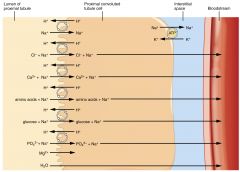![]()
![]()
![]()
Use LEFT and RIGHT arrow keys to navigate between flashcards;
Use UP and DOWN arrow keys to flip the card;
H to show hint;
A reads text to speech;
30 Cards in this Set
- Front
- Back
|
How do substances which enter the kidney reenter the blood stream? |
Through the process of tubular secretion. Some molecules passively diffuse out of the renal tubules. Others are actively tansported. |
|
|
What substances are reabsorbed from the tubules? |
1. Water 2. Na+ 3. Glucose 4. Some urea (44%) |
|
|
Aside from reabsorbing vital molecules, what is another key function of the renal system? |
1. Control of bodily ion balances. |
|
|
Where is the majority of the sodium reabsorbed in the renal tubules? What transporters move it? |
In the proximal tubule it is moved by 1. Na+ / H+ antiporter 2. Na+ / K+ ATPase 3. Na+ / glucose symporter |
|
|
Why are many ion / small molecules movement into (sometimes out of) cells coupled to sodium ions? |
Sodium ions are soluble and can passively diffuse down the electrochemical gradient. This energy can be harnessed exploited by cells via transporters to provide the energy required to simultaneously move another molecule. This is secondary active transport. |
|
|
How are water molecules allowed facilitated diffusion out of the renal tubules? |
Via aquaporins. |
|
|
Where is water mainly reabsorbed? |
67% in the proximal tubule ~20-25% in the loop of henle ~7-10% in the collecting duct |
|
|
Where are the most metabolically active kidney cells found? |
In the proximal convoluted tubule |
|
|
What other substances is Na+ reabsorption in the kidneys linked to? |
Na+ reabsorption is linked to glucose and amino acid reabsorption via symporters. Also linked to bicarbonate and phosphate reabsorption |
|
|
How is a high water permeability in the proximal convuluted tubule maintained? |
Presence of aquaporins. |
|
|
What is the most vital primary active transporter in the kidney? |
The Na+ / K+ dependent ATPase (Na+ out of cells, K+ in) |
|
|
What are the functions of the Na+ / K+ dependent ATPase? |
1. Lowers intracellular sodium ion concentration to 5-10 mM 2. Generates a low electrochemical gradient against tubular fluid. |
|
|
Why is maintaining a low Na+ intracellular concentration vital? |
1. Ensures that all molecules coupled to Na+ symportation from the proximal tubule lumen continue to flow down the Na+ concentration gradient. |
|
|
What molecules are linked to Na+ entry into the proximal convoluted tubule endothelial cells? |

1. Amino acids 2. Calcium ions 3. Chloride ions 4. Phosphate 5. glucose |
|
|
What is Na+ symporation commonly moved against? |
Protons / H+ |
|
|
What is the shunt pathway? |
The shunt pathway is the bulk movement of cations into the interstitial space inbetween the proximal convuluted tubule cells. |
|
|
What drives the shunt pathway? |
The shunt pathway is driven by: 1. The transepithelial electrical gradient 2. Solvent drag by bulk water flow 3. Hydrostatic pressure gradient |
|
|
What ion concentration remains constant throughout the entire length of the proximal convoluted tubule? |
The sodium ion concentration. |
|
|
How is the sodium ion concentration maintained throughout the length of the proximal convoluted tubule? |
As the combination of Na+ and H2O transport keeps the Na+ concentration constant which allows for a constant osmolality and osmolarity. |
|
|
What is the synoptic function of the loop of Henle? |
Generate a steep Na+ gradient in the medulla to encourage water reuptake. |
|
|
Explain the processes underlying the countercurrent mechanism. |
The ascending limb: 1. Impermeable to water, 2. Extrinsic reabsorption of Na+, Cl- & K+. 3. Deposition of Na+, Cl- & K+ into the interstitial fluid drives the shunt pathway - driving even more ions into the interstitial fluid 4. The mass movement of ions with no balancing movement of water generates a hyperosmotic interstitial fluid. The Descending Limb 1. Is permeable to water 2. In response to the hyperosmotic interstitial fluid water flows down the osmotic gradient into the interstitial fluid 3. Water in the interstitial fluid is reabsorbed |
|
|
What are the key channels of the ascending limb? |
1. The Na-K-Cl Symporter 2. The Na-H antiporter |
|
|
What is the Na-K-Cl symporter inhibited by? |
Inhibited by loop diuretic furosemides |
|
|
What are the key features and processes of the early distal convuluted tubule? |
1. Impermeable to water 2. Actively transports Na+ & Cl- out of the lumen into the interstitial fluid - thus increasing the H2O concentration in the lumen. |
|
|
What are the key features and processes of the late distal convuluted tubule? |
1. Permeable to water 2. H2O naturally will diffuse into interstitial fluid out of lumen |
|
|
What is the hormone which controls the water permeability of the collecting duct? |
Vasopressin / AntiDiuretic Hormone (ADH) |
|
|
What is the effect of vasopressin? |
Increases water reuptake by the kidneys. |
|
|
What drug is a K+ sparing diuretic? How does it work? |
Amiloride Blocks ENaC channel to promote the production of urine |
|
|
What is the effect of aldosterone on the kidneys? |
Regulates blood pressure by regulating the reabsorption of ions and water in the kidney. |
|
|
Urea is a toxic substance in concentrations which are too high. Why is it actively reabsorbed? |
So it can be moved into the interstitial space where it helps to maintain a hypertonic interstial space. |

